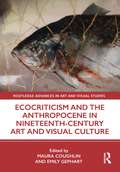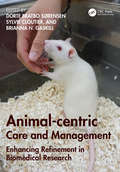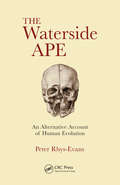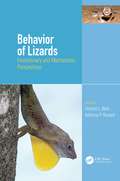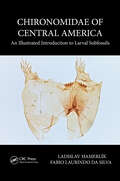- Table View
- List View
Ecocriticism and the Anthropocene in Nineteenth-Century Art and Visual Culture (Routledge Advances in Art and Visual Studies)
by Maura CoughlinIn this volume, emerging and established scholars bring ethical and political concerns for the environment, nonhuman animals and social justice to the study of nineteenth-century visual culture. They draw their theoretical inspiration from the vitality of emerging critical discourses, such as new materialism, ecofeminism, critical animal studies, food studies, object-oriented ontology and affect theory. This timely volume looks back at the early decades of the Anthropocene to query the agency of visual culture to critique, create and maintain more resilient and biologically diverse local and global ecologies.
Fundamentals of Microanalytical Entomology: A Practical Guide to Detecting and Identifying Filth in Foods
by ALAN R. OLSEN; THOMAS H. SIDEBOTTOM; SHERRY A. KNIGHTThis text offers insight into the practical applications of microanalytical entomology in the laboratory and in the field of consumer protection. This is the only guide that gives an overview of the subject from initial analysis of a product to interpreting significance of final results. Complete insect illustrations throughout and an insect fragment identification discussion covers all pests that are found in foods. Micrographs illustrate a complete reference on identifying types of hair contaminants found in various foods. Chapters are written by practicing regulatory experts.
Germfree and Gnotobiotic Animal Models: Background and Applications
by Bernard S. WostmannThe germfree animal is reared in the laboratory to be bacteria free; its counterpart, the gnotobiotic animal, is exposed to select microorganisms. The need for such an animal model for use in biomedical studies was first expressed by Pasteur in the late 1800s. Subsequent development of germfree and gnotobiotic animals led to an explosion of studies on the effects of microflora and its components on the physiology and metabolism of the host. Germfree and Gnotobiotic Animal Models brings together the most notable points of early and recent studies and gives reference to the most pertinent literature.
Infektionskrankheiten der Katze
by Katrin Hartmann Julie K. LevyDer erste in Deutsch erschienene Band aus der Reihe Veterinary Self-Assessment Colour Review behandelt alle Arten der Infektionskrankheiten der Katze. Er umfaßt Infektionen, die von Viren, Bakterien, Parasiten und Pilzen verursacht werden. Die 199 klinischen Fälle werden wie in der Praxis nach dem Zufallsprinzip präsentiert. Die breite Auswahl der Fälle sorgt dafür, daß alle Organsysteme der Katze vorkommen, die von Infektionen befallen werden. Die illustrierten klinischen Fallbeispiele enthalten in den Text integrierte Fragen und ausführlich erklärte Antworten. Das Buch wendet sich an Ärzte in Praxis und Klinik, an Studenten, HelferInnen und Techniker.
Integrated Fish Farming
by Jack A. Mathias Charles AnthonyIf you are looking for wide-ranging international coverage of all aspects of integrated fish forming, this is the book you need. With a carefully selected and fully interdisciplinary collection of papers from experts around the world, Integrated Fish Farming provides thorough, detailed coverage of one of the world's most important approaches to integrated farming systems. Integrated Fish Fanning places IFF in a global context, reporting on case studies of successful IFF operations, experiments to enhance IFF performance, bioeconomic survey and modeling analyses, research on farm waste use and pond ecology, socio-economic elements of IFF extension and adoption, and the bio-technical and economic aspects of adapting IFF to reservoirs, marshlands, rice paddies, and marginal habitats. With contributions from leading international authorities and in-depth information from IFF operations worldwide, this is the definitive reference on Integrated Fish Farming.
The Veterinary ICU Book
by Wayne E. Wingfield Mark R. RaffeThis book is dedicated to the fundamental clinical signs of astute observation, careful differential diagnosis and analytical therapeutic decision-making in emergency veterinary settings. It clearly defines the physiological and clinical principles fundamental to the management of the critically ill small animal patient. With clear guidelines for organizing an emergency/critical care unit, the book also discusses ethical and legal concerns. The 80 expert authors have created a clinically specific resource for the specialist, residents in training, veterinary practitioners, technicians and students.Published by Teton New Media in the USA and distributed by CRC Press outside of North America.
Animal-centric Care and Management: Enhancing Refinement in Biomedical Research
by Dorte Bratbo Sørensen Sylvie Cloutier Brianna N. GaskillThe concept of the 3Rs (Refinement, Reduction and Replacement) has been used as a framework for improving the welfare of laboratory animals for the last half century. By establishing an animal-centric view on housing and management, Animal-centric Care and Management: Enhancing Refinement in Biomedical Research takes Russell and Burch’s definition of Refinement as "elimination of inhumanities" and goes further. Rather than fitting animals into experimental conditions, it encourages readers to adjust conditions to better meet the behavioral, emotional, physical, and physiological needs and preferences of the animals. The team of expert authors, from the fields of laboratory animal science, ethology, biology as well as animal training, provide ideas for creating housing conditions and handling procedures that induce, to the best of current abilities and knowledge, a long-term positive state of mind in the animals under our care. This book is written for animal caretakers, animal health technicians, researchers, animal facility managers, laboratory animal veterinarians, and anyone who engages in work with living experimental animals or is interested in the continuous improvement of laboratory animal welfare. This interdisciplinary guide will act as a catalyst, resulting in multiple viewpoints and fields collaborating to optimize laboratory animal welfare.
Ecocriticism and the Anthropocene in Nineteenth-Century Art and Visual Culture (Routledge Advances in Art and Visual Studies)
by Maura Coughlin Emily GephartIn this volume, emerging and established scholars bring ethical and political concerns for the environment, nonhuman animals and social justice to the study of nineteenth-century visual culture. They draw their theoretical inspiration from the vitality of emerging critical discourses, such as new materialism, ecofeminism, critical animal studies, food studies, object-oriented ontology and affect theory. This timely volume looks back at the early decades of the Anthropocene to query the agency of visual culture to critique, create and maintain more resilient and biologically diverse local and global ecologies.
Fundamentals of Microanalytical Entomology: A Practical Guide to Detecting and Identifying Filth in Foods
by Alan R. OlsenThis text offers insight into the practical applications of microanalytical entomology in the laboratory and in the field of consumer protection. This is the only guide that gives an overview of the subject from initial analysis of a product to interpreting significance of final results. Complete insect illustrations throughout and an insect fragment identification discussion covers all pests that are found in foods. Micrographs illustrate a complete reference on identifying types of hair contaminants found in various foods. Chapters are written by practicing regulatory experts.
Germfree and Gnotobiotic Animal Models: Background and Applications
by Bernard S. WostmannThe germfree animal is reared in the laboratory to be bacteria free; its counterpart, the gnotobiotic animal, is exposed to select microorganisms. The need for such an animal model for use in biomedical studies was first expressed by Pasteur in the late 1800s. Subsequent development of germfree and gnotobiotic animals led to an explosion of studies on the effects of microflora and its components on the physiology and metabolism of the host. Germfree and Gnotobiotic Animal Models brings together the most notable points of early and recent studies and gives reference to the most pertinent literature.
Infektionskrankheiten der Katze
by Katrin Hartmann Julie K. LevyDer erste in Deutsch erschienene Band aus der Reihe Veterinary Self-Assessment Colour Review behandelt alle Arten der Infektionskrankheiten der Katze. Er umfaßt Infektionen, die von Viren, Bakterien, Parasiten und Pilzen verursacht werden. Die 199 klinischen Fälle werden wie in der Praxis nach dem Zufallsprinzip präsentiert. Die breite Auswahl der Fälle sorgt dafür, daß alle Organsysteme der Katze vorkommen, die von Infektionen befallen werden. Die illustrierten klinischen Fallbeispiele enthalten in den Text integrierte Fragen und ausführlich erklärte Antworten. Das Buch wendet sich an Ärzte in Praxis und Klinik, an Studenten, HelferInnen und Techniker.
Integrated Fish Farming
by Jack A. Mathias Charles AnthonyIf you are looking for wide-ranging international coverage of all aspects of integrated fish forming, this is the book you need. With a carefully selected and fully interdisciplinary collection of papers from experts around the world, Integrated Fish Farming provides thorough, detailed coverage of one of the world's most important approaches to integrated farming systems. Integrated Fish Fanning places IFF in a global context, reporting on case studies of successful IFF operations, experiments to enhance IFF performance, bioeconomic survey and modeling analyses, research on farm waste use and pond ecology, socio-economic elements of IFF extension and adoption, and the bio-technical and economic aspects of adapting IFF to reservoirs, marshlands, rice paddies, and marginal habitats. With contributions from leading international authorities and in-depth information from IFF operations worldwide, this is the definitive reference on Integrated Fish Farming.
The Veterinary ICU Book
by Wayne E. Wingfield Mark R. RaffeThis book is dedicated to the fundamental clinical signs of astute observation, careful differential diagnosis and analytical therapeutic decision-making in emergency veterinary settings. It clearly defines the physiological and clinical principles fundamental to the management of the critically ill small animal patient. With clear guidelines for organizing an emergency/critical care unit, the book also discusses ethical and legal concerns. The 80 expert authors have created a clinically specific resource for the specialist, residents in training, veterinary practitioners, technicians and students.Published by Teton New Media in the USA and distributed by CRC Press outside of North America.
Handbook of Venoms and Toxins of Reptiles
by Stephen P. MackessyA decade after publication of the first edition, Handbook of Venoms and Toxins of Reptiles responds to extensive changes in the field of toxinology to endure as the most comprehensive review of reptile venoms on the market. The six sections of this new edition, which has nearly doubled in size, complement the original handbook by presenting current information from many of the leading researchers and physicians in toxinology, with topics ranging from functional morphology, evolution and ecology to crystallography, -omics technologies, drug discovery and more. With the recent recognition by the World Health Organization of snakebite as a neglected tropical disease, the section on snakebite has been expanded and includes several chapters dealing with the problem broadly and with new technologies and the promises these new approaches may hold to counter the deleterious effects of envenomation. This greatly expanded handbook offers a unique resource for biologists, biochemists, toxicologists, physicians, clinicians, and epidemiologists, as well as informed laypersons interested in the biology of venomous reptiles, the biochemistry and molecular biology of venoms, and the effects and treatment of human envenomation.
Handbook of Venoms and Toxins of Reptiles
by Stephen P. MackessyA decade after publication of the first edition, Handbook of Venoms and Toxins of Reptiles responds to extensive changes in the field of toxinology to endure as the most comprehensive review of reptile venoms on the market. The six sections of this new edition, which has nearly doubled in size, complement the original handbook by presenting current information from many of the leading researchers and physicians in toxinology, with topics ranging from functional morphology, evolution and ecology to crystallography, -omics technologies, drug discovery and more. With the recent recognition by the World Health Organization of snakebite as a neglected tropical disease, the section on snakebite has been expanded and includes several chapters dealing with the problem broadly and with new technologies and the promises these new approaches may hold to counter the deleterious effects of envenomation. This greatly expanded handbook offers a unique resource for biologists, biochemists, toxicologists, physicians, clinicians, and epidemiologists, as well as informed laypersons interested in the biology of venomous reptiles, the biochemistry and molecular biology of venoms, and the effects and treatment of human envenomation.
The Waterside Ape: An Alternative Account of Human Evolution
by Peter H. Rhys EvansWhy are humans so fond of water? Why is our skin colour so variable? Why aren’t we hairy like our close ape relatives? A savannah scenario of human evolution has been widely accepted primarily due to fossil evidence; and fossils do not offer insight into these questions. Other alternative evolutionary scenarios might, but these models have been rejected. This book explores a controversial idea – that human evolution was intimately associated with watery habitats as much or more than typical savannahs. Written from a medical point of view, the author presents evidence supporting a credible alternative explanation for how humans diverged from our primate ancestors. Anatomical and physiological evidence offer insight into hairlessness, different coloured skin, subcutaneous fat, large brains, a marine-type kidney, a unique heat regulation system and speech. This evidence suggests that humans may well have evolved, not just as savannah mammals, as is generally believed, but with more affinity for aquatic habitats – rivers, streams, lakes and coasts. Key Features: Presents the evidence for a close association between riparian habitats and the origin of humans Reviews the "savannah ape" hypothesis for human origins Describes various anatomical adaptations that are associated with hypotheses of human evolution Explores characteristics from the head and neck such as skull and sinus structures, the larynx and ear structures and functions Corroborates a novel scenario for the origin of human kind ‘… a counterpoint to the textbooks or other books which deal with human evolution. I think readers will see it as a clearly written, well-supported discussion of an alternativeperspective on human origins’. —Kathlyn Stewart, Canadian Museum of Nature, Ottawa ‘There is a pressing need to expand discussions of human evolution to includenon-anthropocentric narratives that use comparative data. Dr Rhys-Evans’ specific expertise and experience with the human head, neck, ears, throat, mouth and sinuses, provides him with a distinct perspective from which to approach the subject of human evolution. Moreover, his understanding of non-anthropocentric views of human evolution (water-based models), allow him to apply a biological approach to the subject, missing in more traditional (savannah-based) models’. —Stephen Munro, National Museum of Australia
Rapid Review of ECG Interpretation in Small Animal Practice
by Mark A Oyama Marc S. Kraus Anna R GelzerThe standard electrocardiogram (ECG) is an indispensable, safe, and inexpensive test to assess dogs and cats with heart disease. This bestselling user-friendly book discusses the principles of electrocardiography, then systematically explores the evaluation of the ECG, including determination of heart rate, measurement of intervals, derivation of mean electrical axis, and criteria for atrial/ventricular enlargement or hypertrophy. At the core of this book is an extensive series of ECG cases for the reader to work through: practice makes perfect. New to this edition: Instructions on how to obtain an ECG A new chapter on the treatment of the most common clinically important ECG arrhythmias A second new chapter on 24-hour ECG (Holter) monitoring A handy one-page reference guide of important ECG values and diagrams, which can be downloaded from the book's webpage for easy reference 15 new ECG cases have been added to the original 46 cases, with a selection of advanced cases geared toward readers craving more challenging topics such as electrical cardioversion and pacemaker function. This updated edition will further aid veterinarians in their quest to better interpret the ECG. It provides information in an appealing, accessible, and easy to use format that fits with the busy lives of veterinary practitioners.
The Waterside Ape: An Alternative Account of Human Evolution
by Peter H. Rhys EvansWhy are humans so fond of water? Why is our skin colour so variable? Why aren’t we hairy like our close ape relatives? A savannah scenario of human evolution has been widely accepted primarily due to fossil evidence; and fossils do not offer insight into these questions. Other alternative evolutionary scenarios might, but these models have been rejected. This book explores a controversial idea – that human evolution was intimately associated with watery habitats as much or more than typical savannahs. Written from a medical point of view, the author presents evidence supporting a credible alternative explanation for how humans diverged from our primate ancestors. Anatomical and physiological evidence offer insight into hairlessness, different coloured skin, subcutaneous fat, large brains, a marine-type kidney, a unique heat regulation system and speech. This evidence suggests that humans may well have evolved, not just as savannah mammals, as is generally believed, but with more affinity for aquatic habitats – rivers, streams, lakes and coasts. Key Features: Presents the evidence for a close association between riparian habitats and the origin of humans Reviews the "savannah ape" hypothesis for human origins Describes various anatomical adaptations that are associated with hypotheses of human evolution Explores characteristics from the head and neck such as skull and sinus structures, the larynx and ear structures and functions Corroborates a novel scenario for the origin of human kind ‘… a counterpoint to the textbooks or other books which deal with human evolution. I think readers will see it as a clearly written, well-supported discussion of an alternativeperspective on human origins’. —Kathlyn Stewart, Canadian Museum of Nature, Ottawa ‘There is a pressing need to expand discussions of human evolution to includenon-anthropocentric narratives that use comparative data. Dr Rhys-Evans’ specific expertise and experience with the human head, neck, ears, throat, mouth and sinuses, provides him with a distinct perspective from which to approach the subject of human evolution. Moreover, his understanding of non-anthropocentric views of human evolution (water-based models), allow him to apply a biological approach to the subject, missing in more traditional (savannah-based) models’. —Stephen Munro, National Museum of Australia
Rapid Review of ECG Interpretation in Small Animal Practice
by Mark A Oyama Marc S. Kraus Anna R GelzerThe standard electrocardiogram (ECG) is an indispensable, safe, and inexpensive test to assess dogs and cats with heart disease. This bestselling user-friendly book discusses the principles of electrocardiography, then systematically explores the evaluation of the ECG, including determination of heart rate, measurement of intervals, derivation of mean electrical axis, and criteria for atrial/ventricular enlargement or hypertrophy. At the core of this book is an extensive series of ECG cases for the reader to work through: practice makes perfect. New to this edition: Instructions on how to obtain an ECG A new chapter on the treatment of the most common clinically important ECG arrhythmias A second new chapter on 24-hour ECG (Holter) monitoring A handy one-page reference guide of important ECG values and diagrams, which can be downloaded from the book's webpage for easy reference 15 new ECG cases have been added to the original 46 cases, with a selection of advanced cases geared toward readers craving more challenging topics such as electrical cardioversion and pacemaker function. This updated edition will further aid veterinarians in their quest to better interpret the ECG. It provides information in an appealing, accessible, and easy to use format that fits with the busy lives of veterinary practitioners.
Diseases and Pathology of Reptiles: Color Atlas and Text, Two Volume Set
by Elliott Jacobson Michael GarnerThis two-volume set represents a second edition of the original Infectious Diseases and Pathology of Reptiles alongside a new book that covers noninfectious diseases of reptiles. Together, these meet the need for an entirely comprehensive, authoritative single-source reference. The volumes feature color photos of normal anatomy and histology, as well as gross, light, and electron microscopic images of infectious and noninfectious diseases of reptiles. The most detailed and highly illustrated reference on the market, this two-volume set includes definitive information on every aspect of the anatomy, pathophysiology, and differential diagnosis of infectious and noninfectious diseases affecting reptiles.
Behavior of Lizards: Evolutionary and Mechanistic Perspectives
by Vincent L. Bels Anthony P. RussellKey features: Presents a contemporary snapshot of the mechanisms underlying the evolution and adaptation of behavior Explores how genetics, epigenetics, development, and environment shape behavior Discusses a broad range of behavioral repertoires and responses, including those related to thermoregulatory, foraging, predatory, displaying, social and escape strategies. Examines physiological and sensory mechanisms Covers the effects of various aspects of global change on behavior, with chapters that focus on the impacts of climate change on hydroregulatory behavior and behavioral responses to the effects of habitat alteration resulting from human-mediated change and colonization by invasive species. Lizards serve as focal organisms for many of biological questions related to evolution, ecology, physiology, and morphology. They are studied at multiple spatial and temporal scales, from the individual to the community level. This book, authored by expert contributors from around the world, explores behaviors underlying the evolution and adaptation of these organisms. It covers conceptual, empirical, and methodological approaches to the understanding of the role that natural and sexual selection play in molding the behavioral traits of lizards. This thorough, illustrated reference should stimulate discussion of the conceptual and methodological approaches for studying the behavioral traits of these fascinating and highly diverse vertebrates.
Behavior of Lizards: Evolutionary and Mechanistic Perspectives
by Vincent Bels Anthony RussellKey features: Presents a contemporary snapshot of the mechanisms underlying the evolution and adaptation of behavior Explores how genetics, epigenetics, development, and environment shape behavior Discusses a broad range of behavioral repertoires and responses, including those related to thermoregulatory, foraging, predatory, displaying, social and escape strategies. Examines physiological and sensory mechanisms Covers the effects of various aspects of global change on behavior, with chapters that focus on the impacts of climate change on hydroregulatory behavior and behavioral responses to the effects of habitat alteration resulting from human-mediated change and colonization by invasive species. Lizards serve as focal organisms for many of biological questions related to evolution, ecology, physiology, and morphology. They are studied at multiple spatial and temporal scales, from the individual to the community level. This book, authored by expert contributors from around the world, explores behaviors underlying the evolution and adaptation of these organisms. It covers conceptual, empirical, and methodological approaches to the understanding of the role that natural and sexual selection play in molding the behavioral traits of lizards. This thorough, illustrated reference should stimulate discussion of the conceptual and methodological approaches for studying the behavioral traits of these fascinating and highly diverse vertebrates.
Chironomidae of Central America: An Illustrated Introduction To Larval Subfossils
by Ladislav Hamerlik Fabio Laurindo da SilvaThis illustrated introduction to Central American Chironomidae offers extensive photographic material, as well as detailed morphological and ecological descriptions of chironomid subfossils found in Central American lake sediments. The book uniquely provides two identification keys: one for living larvae occurring (or potentially being present) in Central America and one for the recorded subfossil remains, using limited morphological characters. Paleolimnological investigations using chironomid remains have undergone a resurgence of interest, and this taxonomic guide will aid the thorough analysis of the diversity and distribution of the taxa encountered to date in Central America. Out of the total 64 described genera, the book brings 20 endemic genera, and more than half of the presented morphotypes are new. Plates are included for each taxon with generic characters and also provide a key to morphotypes, if present, their specific characters, distribution, and ecology. Authored by a (paleo)limnologist and a taxonomist, the guide draws on a thorough taxonomical knowledge of the region’s recent chironomid fauna. It uses a paleolimnological approach to transmit this information to morphotypes that can be linked with ecology and used to reconstruct the past development of nature. The book thus helps paleo-workers and taxonomists to learn more about these fascinating insects and, through them, to discover the world around us. Providing a comprehensive reference for aquatic ecologists, paleolimnologists, students, and researchers, the guide will also be of interest to non-academic professionals working on applied research and biomonitoring of lakes. It will be useful for people studying both recent and subfossil material, not only in Central America, but in the whole Neotropical region.
Chironomidae of Central America: An Illustrated Introduction To Larval Subfossils
by Ladislav Hamerlik Fabio Laurindo da SilvaThis illustrated introduction to Central American Chironomidae offers extensive photographic material, as well as detailed morphological and ecological descriptions of chironomid subfossils found in Central American lake sediments. The book uniquely provides two identification keys: one for living larvae occurring (or potentially being present) in Central America and one for the recorded subfossil remains, using limited morphological characters. Paleolimnological investigations using chironomid remains have undergone a resurgence of interest, and this taxonomic guide will aid the thorough analysis of the diversity and distribution of the taxa encountered to date in Central America. Out of the total 64 described genera, the book brings 20 endemic genera, and more than half of the presented morphotypes are new. Plates are included for each taxon with generic characters and also provide a key to morphotypes, if present, their specific characters, distribution, and ecology. Authored by a (paleo)limnologist and a taxonomist, the guide draws on a thorough taxonomical knowledge of the region’s recent chironomid fauna. It uses a paleolimnological approach to transmit this information to morphotypes that can be linked with ecology and used to reconstruct the past development of nature. The book thus helps paleo-workers and taxonomists to learn more about these fascinating insects and, through them, to discover the world around us. Providing a comprehensive reference for aquatic ecologists, paleolimnologists, students, and researchers, the guide will also be of interest to non-academic professionals working on applied research and biomonitoring of lakes. It will be useful for people studying both recent and subfossil material, not only in Central America, but in the whole Neotropical region.
Behavioral Biology of Laboratory Animals
by Kristine Coleman Steven J. SchapiroThis 30-chapter volume informs students and professionals about the behavioral biology of animals commonly housed in laboratory and other captive settings. Each species evolved under specific environmental conditions, resulting in unique behavioral patterns, many of which are maintained in captivity even after generations of breeding. Understanding natural behavior is therefore a critical part of modern animal care practices. The descriptions, data, guidance, resources, and recommendations in this book will help the reader understand their animals better, refine the care and treatment that they receive, and improve the well-being, welfare, and wellness of their animals. The book is divided into three sections, all focusing on aspects of the behavioral biology of animals found in laboratories and related research settings. After five introductory chapters, 25 chapters are dedicated to specific taxonomic groups (including mice, zebrafish, zebra finches, reptiles, macaques) while a concluding section of ethograms provides a centralized resource for those interested in understanding, and potentially quantifying, animal behavior. The Behaviorial Biology of Laboratory Animals will provide anyone working in maintenance, care, and/or research programs that involve laboratory animals with information about the way the animals live in the wild, and the way that they should live in captive research settings. Many of the guidelines and recommendations will also be valuable to those managing and working with animals in other environments, including zoological parks, aquaria, and sanctuaries.
